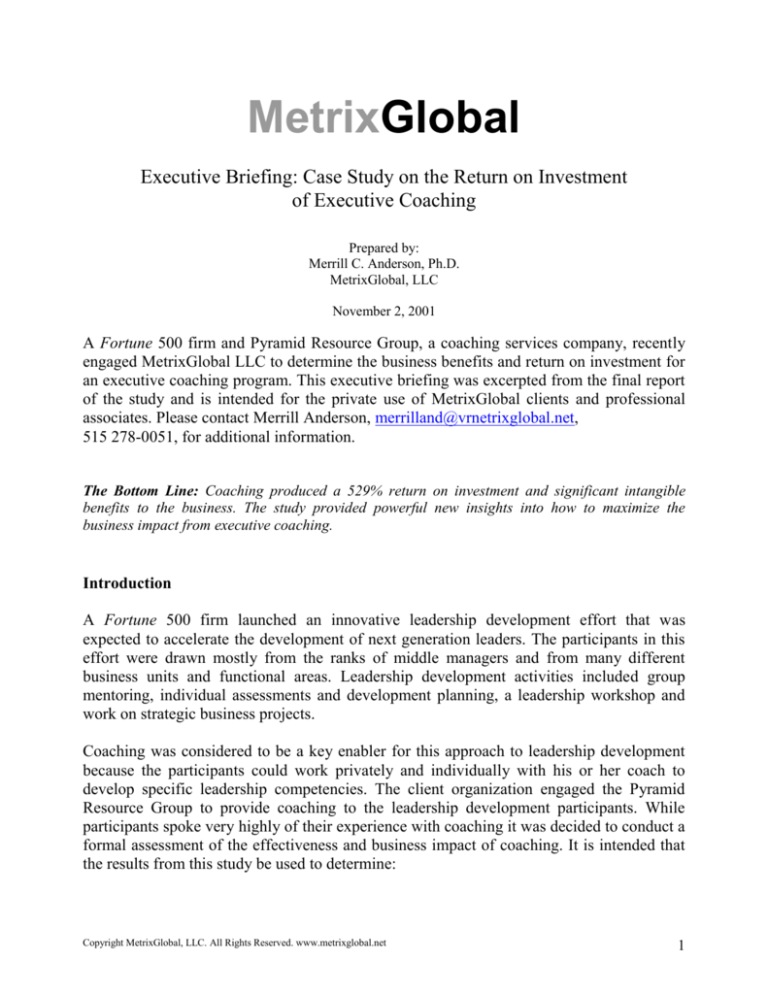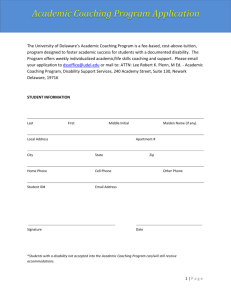
MetrixGlobal
Executive Briefing: Case Study on the Return on Investment
of Executive Coaching
Prepared by:
Merrill C. Anderson, Ph.D.
MetrixGlobal, LLC
November 2, 2001
A Fortune 500 firm and Pyramid Resource Group, a coaching services company, recently
engaged MetrixGlobal LLC to determine the business benefits and return on investment for
an executive coaching program. This executive briefing was excerpted from the final report
of the study and is intended for the private use of MetrixGlobal clients and professional
associates. Please contact Merrill Anderson, merrilland@vrnetrixglobal.net,
515 278-0051, for additional information.
The Bottom Line: Coaching produced a 529% return on investment and significant intangible
benefits to the business. The study provided powerful new insights into how to maximize the
business impact from executive coaching.
Introduction
A Fortune 500 firm launched an innovative leadership development effort that was
expected to accelerate the development of next generation leaders. The participants in this
effort were drawn mostly from the ranks of middle managers and from many different
business units and functional areas. Leadership development activities included group
mentoring, individual assessments and development planning, a leadership workshop and
work on strategic business projects.
Coaching was considered to be a key enabler for this approach to leadership development
because the participants could work privately and individually with his or her coach to
develop specific leadership competencies. The client organization engaged the Pyramid
Resource Group to provide coaching to the leadership development participants. While
participants spoke very highly of their experience with coaching it was decided to conduct a
formal assessment of the effectiveness and business impact of coaching. It is intended that
the results from this study be used to determine:
Copyright MetrixGlobal, LLC. All Rights Reserved. www.metrixglobal.net
1
1. How did coaching add value to the business and what was the return on investment?
2. How could coaching be best leveraged in the future, especially if coaching was to be
expanded to other business regions?
Data Collection Procedures
It was decided that the best way to isolate and capture the effects of coaching on the
business was through a questionnaire. This questionnaire had two parts. Part one was
completed electronically via email and examined clients initial reaction to coaching, what
they learned, how they applied what they learned and captured their initial assessment of
business impact. Part two was conducted over the telephone with each respondent and
probed more deeply into business impact and the financial return on investment.
The target population for the survey was 43 leadership development participants. These
participants were drawn from two regions: Eastern United States (37) and Mexico (6).
These participants represented a cross section of the business and included those in sales,
operations, technology, finance and marketing. All had been identified as potential leaders
and executives. Thirty (30) of 43 leadership development participants returned their
surveys for a 70% response rate.
Results
Coaching was a very effective developmental tool for the leadership development
participants, producing financial and intangible benefits for the business. Coaching
sessions were rich learning environments that enabled the learning to be applied to a
variety of business situations. Decision-making, team performance and the motivation of
others were enhanced. Many of these business applications contributed annualized
financial benefits. Other applications created significant intangible benefits. Overall, the
participants appreciated their coaching experiences and would highly recommend
coaching to others.
Three-quarters (77%) of the 30 respondents indicated that coaching had significant or very
significant impact on at least one of nine business measures. In-depth discussions were
conducted over the telephone with each respondent to further explore the business impact
of coaching. Sixty percent of the respondents were able to identify specific financial
benefits that came as a result of their coaching.
Overall, productivity (60% favorable) and employee satisfaction (53%) were cited as the
most significantly impacted by the coaching. Respondents defined productivity in this
context as relating to their personal or to their work group productivity and half (50%)
documented annualized financial benefits. Employee satisfaction was viewed both in terms
of the respondents being personally more satisfied as a result of the coaching as well as the
being able to increase the employee satisfaction of their team members. The respondents
could not quantify this benefit in financial terms. Employee satisfaction,
Copyright MetrixGlobal, LLC. All Rights Reserved. www.metrixglobal.net
2
then, was a significant source of intangible benefits. Customer satisfaction (53%) was also a
significant source of intangible benefits.
The next most frequently cited as being significantly impacted by coaching were work
output (30%) and work quality (40%). Twenty percent of the respondents identified
financial benefits as a result of increased work output. Many respondents reported
improvements in work quality, however, they were not able to quantify these
improvements in terms of dollar benefits. Work quality improvements were considered an
intangible benefit of the coaching.
Program costs were tabulated for all 43 leadership development participants in determining
the return on investment. A 529% return on investment was produced by the coaching
process (excluding the benefits from employee retention). While those clients who had
customer or people responsibilities produced proportionally greater financial benefits, the
realization of benefits to the business was fairly widespread throughout the group involved
in this study.
Recommendations were made to maximize the business benefits from executive coaching:
Manage the entire coaching process to ensure consistency and quality. Though the
content of individual coaching sessions should always be confidential, the coaching
process itself needs to be managed to ensure that the coaching clients and the coaches
are following the appropriate process and leveraging best practices.
Prepare clients in advance for coaching and don't force coaching on anyone. Because
coaching remains a relatively new development technique, people may not understand
how the coaching process can help them become better business professionals. The
sooner they understand the process, the sooner they will see results.
Offer clients the ability to select their coaches. Chemistry is important to build an
effective coaching relationship. Provide prospective coaching clients with information
about the coaches including biographies, education, coaching credentials, functional
expertise, industry experience and other background information.
Provide coaching strong organizational support. Those being coached should receive
encouragement and support from their immediate managers. Also, coaching should be
conducted in the context of other developmental efforts such as competency
development, assessments, mentoring and leadership workshops.
Ensure coaches are grounded in the company's business and culture. Coaches are
more effective when they can identify with and talk about the realities of their client's
environment.
Copyright MetrixGlobal, LLC. All Rights Reserved. www.metrixglobal.net
3
Allow each coaching relationship to follow its own path. A major difference between
coaching and training is that coaching allows the individual to determine what works
best for him or her at a very personal level. Coaches need wide latitude to work with
"the whole person" and help each client be more effective as a person as well as to be
more effective as a business leader.
Build performance measurement into the coaching process. Evaluation of coaching
should be designed into the process from the beginning to better set performance
expectations and open up new learning opportunities for making coaching more
effective while the coaching is being conducted. For example, coaching can be
refocused to deal with issues or to ensure that business priorities will be met. In this
way, the evaluation of coaching becomes more than just a measuring stick - it becomes
a structured approach to deepen the business value of coaching.
About MetrixGlobal, LLC
MetrixGlobal LLC is a professional services firm specializing in performance measurement
solutions that increase accountability for bottom-line business results. Whether it's developing a
scorecard for a corporate university, determining return on investment for a human resources
program or conducting a business impact study on an organization change initiative, MetrixGlobal
consultants partner with clients to create powerful measurement methodology. Please visit our web
site, www.metrixglobal.net to learn more about us.
Advantages of pairing workshop training and coaching:
ensures transfer of learning from the classroom to the workplace
provides safe opportunities to practice using new skills
increases retention of learning by 75%
in group coaching, participants learn from each other
further customizes the training by creating opportunity for participants to apply new skills to specific
real-time situations
dramatically increases likelihood of behavior change and increased effectiveness
increases your training ROI!
Copyright MetrixGlobal, LLC. All Rights Reserved. www.metrixglobal.net
4
Copyright MetrixGlobal, LLC. All Rights Reserved. www.metrixglobal.net
5







